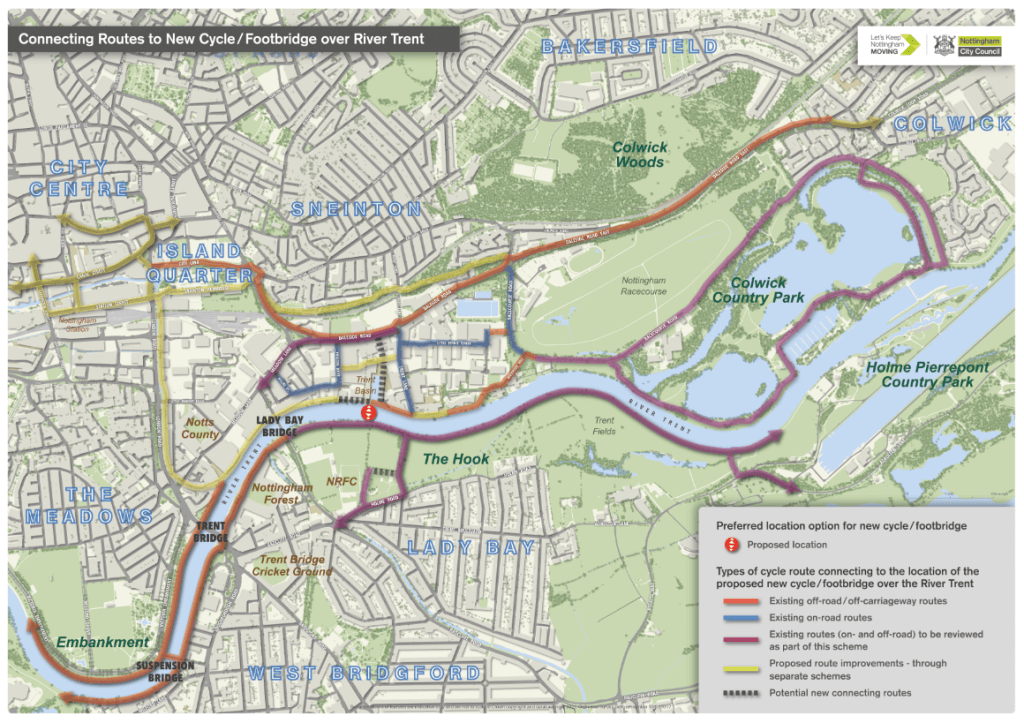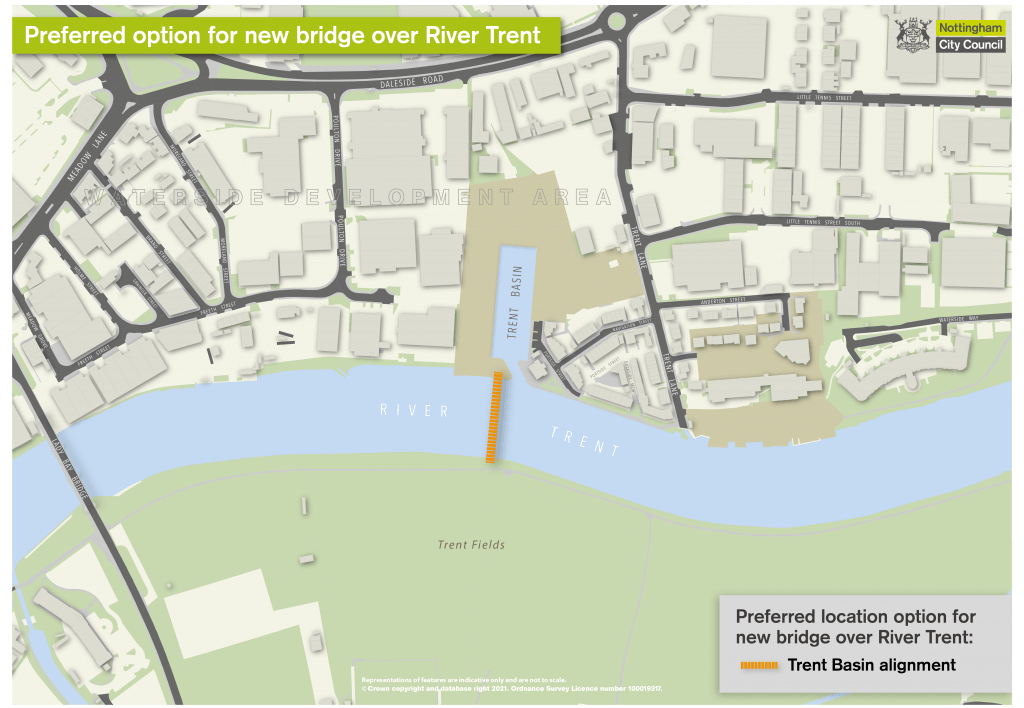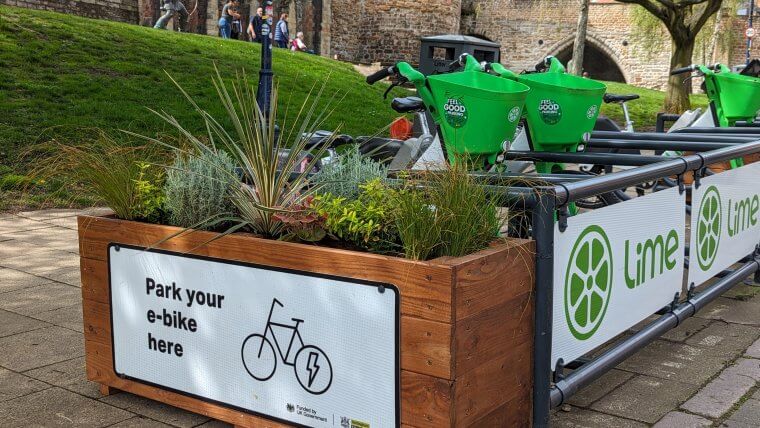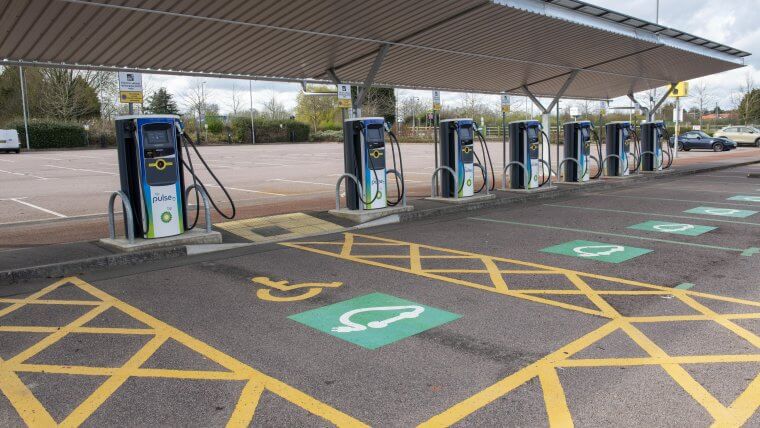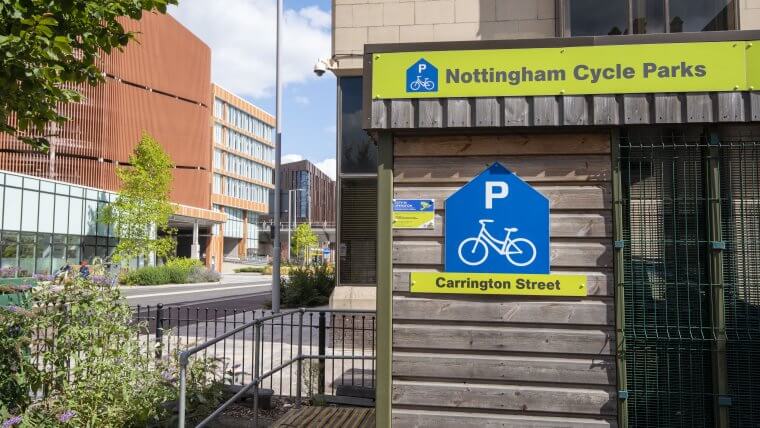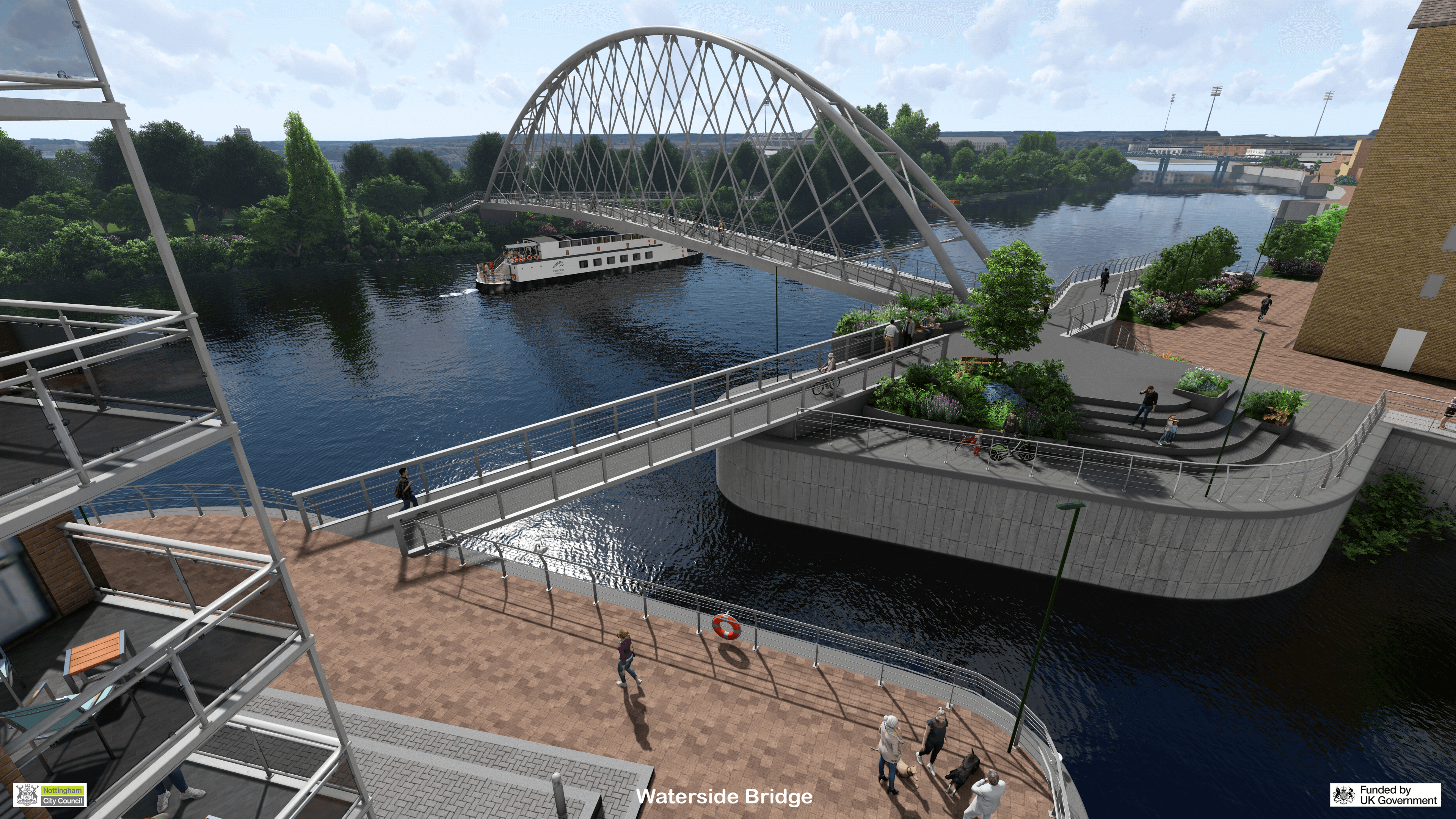
Plans are progressing on the new Transforming Cities-funded pedestrian and cyclist bridge across the River Trent, opening up new links between the expanding Waterside regeneration area, Colwick Park on the north bank, and the Lady Bay/West Bridgford area to the south.
In early 2024, Nottingham City Council submitted planning applications for the new bridge.
Nottingham City Council’s Planning Committee will review the application on April 17 – we are waiting to hear a date when Rushcliffe will review their application.
- Planning application with Nottingham City Council
- Planning application with Rushcliffe Borough Council
You’ll find information what has so far been achieved, along with next steps, background to this project and an FAQ on this page.
What’s happened so far?
2020 – Secured Government funding through the Transforming Cities Fund
2021 – Option appraisal of bridge locations undertaken by Amey Consulting.
Environmental surveys, flood modelling and stakeholder engagement carried out
November 2021 Public invited to share their views on the preferred scheme location
December 2021 Nottingham City Council Executive Board approved the location of the bridge at Trent Basin, and gave approval to progress the scheme and submit a planning application
2022 We reviewed feedback from the public, which resulted in the width of the bridge being increased to 4m and additional connecting routes being considered
2022 We engaged with a contractor (Balfour Beatty) to to clarify key areas including costs buildability, how the bridge will be constructed on site and the land take requirements for this.
2022 & 2023 The project team have continued to work with adjacent landowners to map out the processes to secure agreements to construct the bridge and connect it to the existing highway network.
2022 & 2023 Further work was undertaken to support the planning application submission including flood modelling and environmental surveys such as tree, bat, water vole and other vegetation and species surveys. Work has also progressed to determine the construction methodology including the proposed construction haul routes.
Planning application
We submitted planning applications in February 2024.
Next steps –
2024
- Progress through the planning application process with NCC and RBC
- Detailed design work
- Ground and ecological surveys
- Land agreements to be finalised and confirmed
- Continue to engage with residents and stakeholders
Early 2025 Construction works start
Late 2025 Bridge opens
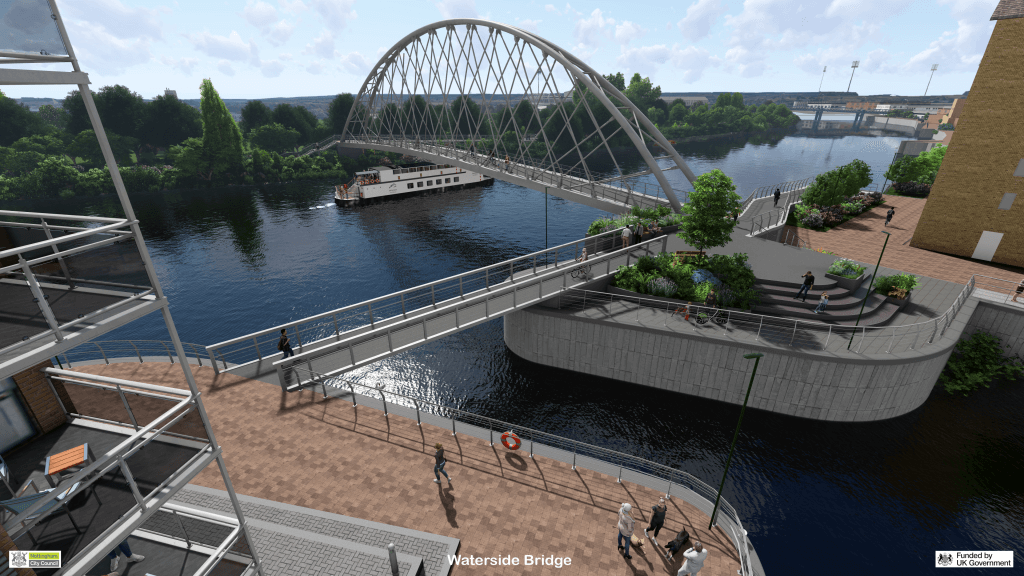
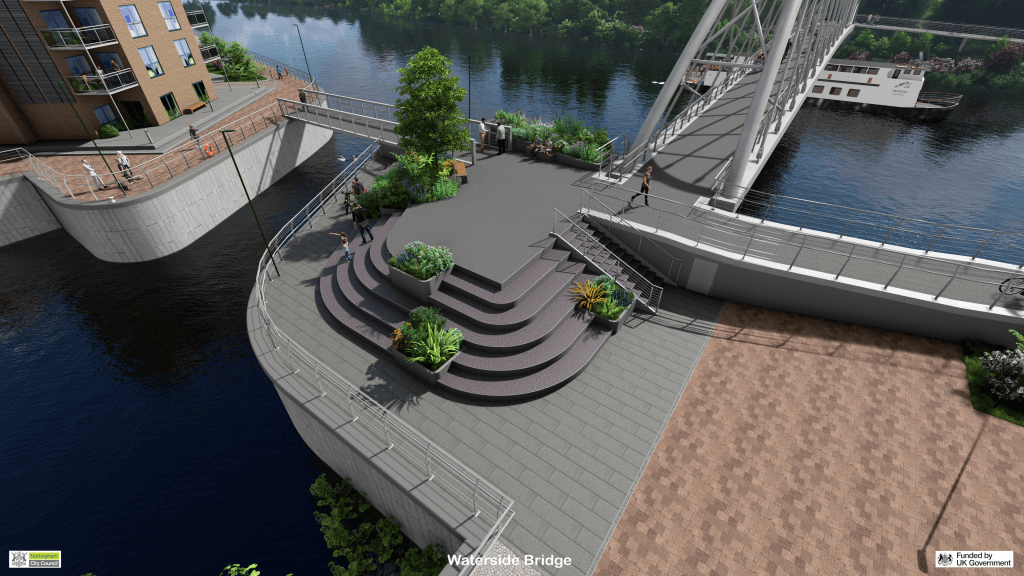
Cost
The cost of the scheme has increased in part due to changes to the design, further clarity on the construction processes and inflationary pressures caused by the war in Ukraine and Covid-19.
Funding has been set aside within the wider Transforming Cities Fund programme to deliver the scheme.
The current construction cost estimate is around £12m including contingency and this will be refined following the planning process.
Background to the project
The Waterside Bridge will be the first bridge to be built over the Trent in Nottingham for more than 60 years, and will open up new, safer commuter and leisure routes, offering a huge boost to cyclists, pedestrians and runners alike.
By enhancing connections between communities, green spaces and riverside paths, the proposed scheme will make it easier for people living and working in the Nottingham area to travel in a more sustainable way.
In addition, new and enhanced connecting paths and crossing points will be developed, which will connect the bridge to the wider walking and cycling network, providing access to housing, employment and leisure opportunities across the city and beyond.
The new bridge will also provide strong links between exciting new developments in the Island Quarter, significant housing growth taking place in West Bridgford, and Nottingham city centre.
It will also provide easier access to green and open space south of the river, as well as the sports grounds, for people living in communities such as Sneinton and the city centre.
The project is being led by Nottingham City Council, working in partnership with Rushcliffe Borough Council and in consultation with Nottinghamshire County Council.
The need for a bridge was identified in the City Council’s Waterside Supplementary Planning document in 2019. The council secured funding from the Government’s Transforming Cities programme to deliver this scheme as part of a programme to invest in local transport infrastructure that will improve sustainable transport, support growth, and encourage more low carbon journeys.
Why has Trent Basin been chosen as the location?
The City Council in partnership with the neighbouring local authorities of Derby, Derbyshire and Nottinghamshire examined the strategic cycle and walking network and recognised the need for more places to be able to cross the Trent safely.
This supports earlier work undertaken as part of the Waterside Regeneration Area consultation, where the idea of a new pedestrian and cycle bridge in the proposed location was first put to the public.
The new bridge, for walking and cycling, will open up new, quieter routes for travel and will also create new opportunities for local trip making and build upon the increase in cycling and walking trip making that was observed during lockdown.
The bridge will greatly improve connectivity in the Waterside area, but the benefits will also be seen by people living much further afield. There is huge demand for travel over the Trent and a new bridge will enable people to have a greater travel choice by opening up walking and cycling as an option as part of the commute and for leisure.
We also know there is a demand for better walking and cycling routes on both Lady Bay Bridge and Trent Bridge. These do still feature in future plans and will be assessed against other improvements needed across the city, however a new bridge will greatly enhance the walking and cycling network and can be built and used without disruption or loss of capacity for public transport and other motorised transport.
What benefits will the new bridge provide?
The new bridge scheme will offer:
- a dedicated pedestrian and cycle bridge over the river Trent
- a new east-west connection over the head of Trent Basin (on the northern bank) to enable east-west connectivity alongside the river for cyclists and pedestrians
- new commuting route options for trips into Nottingham, the QMC, university sites and science parks from the south of the river
- a link across the river from the new housing and developments sites within the Waterside Regeneration Zone on the northern side to the green spaces on the south and to the National Water Sports Centre
- better access to the various sports grounds and sporting facilities in the area
- new opportunities for leisure trip making for pedestrian, runners and cyclists from either side of the river
- more circular route options for cyclists, walkers and runners who will be able to cross the Trent at the new bridge and use the existing bridges to create ‘loops’
- a safe and direct route connecting residents on the south of the river to Colwick Park (including Parkrun) on the north of the river, when combined with new path upgrade proposals on the northern side
- new and enhanced views of the river and its wildlife, and opportunities to get out and about supporting physical and mental well being
- Alleviation of traffic pressures on both Trent Bridge and Lady Bay bridge through increased sustainable travel
Frequently Asked Questions
Isn’t this work impacted by the City Council issuing a Section 114 notice?
The Waterside Bridge project is being delivered using grant funding secured from Central Government through the Transforming Cities programme.
While the Section 114 report means that money Nottingham City Council can spend is currently strictly controlled, because external grant funding has previously been specifically allocated and approved for this scheme it can go ahead.
They money allocated to us by Government from this fund cannot be spent on anything else.
Why have you chosen to locate a bridge here?
The location offers a good balance between providing for leisure and commuter use. It is down the river from Lady Bay bridge while being close enough to Colwick Park that when combined with proposed improvements to the paths along the banks of the Trent it will greatly improve access for walking and cycling.
Why don’t you just improve Lady Bay Bridge or Trent Bridge?
To provide a suitable route significantly more investment would be required on existing bridges. By focusing on a new bridge it also means there is significantly less disruption to travel while the bridge is constructed.
Why can’t this money be put toward a bridge for cars (such as the ‘fourth Trent Crossing’)?
The money has been provided by the Government to support sustainable travel. While not cheap, a walking and cycling bridge will cost significantly less than a bridge that can take motor traffic.
Encouraging more sustainable, lower carbon journeys is an important part of our plan to achieve Carbon Neutral Nottingham 2028. We need to create the necessary infrastructure to enable people to make smarter choices about how they travel, reducing our impact on climate change.
Will boats be able to sail under the bridge?
We are working closely with boat operators and sailing clubs and talking to the Canal and River Trust to ensure we accommodate the needs of existing users. The navigable height will allow clearance for a single handed sailing boat and for tourist/event boats. It is 6.4 metres above a water level of 21.00.
How wide will the bridge be?
We are proposing to make the bridge deck and ramps 4m wide to allow pedestrians and cyclists to easily pass and allow people to stop and enjoy the view.
Will electric scooters be able to use the bridge?
The City Council previously allowed Superpedestrian e-scooters to use the highway on a trial basis. Since Superpedestrian ceased operating, a new operator will be chosen soon.
Privately owned electric scooters can only be used on private land. Nottinghamshire County Council does not permit an e-scooter scheme, and as the bridge crosses the boundary between the city and county if the bridge was open now you would be able to get to the bridge on the north side by e-scooter but you would not be able to cross.
How will you stop vehicles from using the bridge?
Suitable measures will be in place to prevent vehicles attempting to access the bridge through areas designated for walking and cycling. If necessary, measures will be placed on the bridge that will inhibit vehicles but not make it difficult for wheelchairs, adapted bikes, pedestrians or cyclists.



